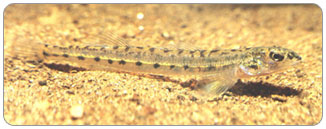|
|
||||||||||
|
|
|
|
|
|
||||||
|
|
||||||||||
 |
 |
Scientific name: |
||||
EASTERN SAND DARTER
![]()
Once populous over a wide territory, eastern sand darters have been
dwindling in numbers since the start of the 20th century—and have vanished
entirely from some of their original territory.
About the eastern sand darter
Eastern sand darters feed on midge and black-fly larvae for the most part. Their food choice is limited somewhat by the fact that their mouths are relatively small and their range restricted.
How to recognize the eastern sand darter
This small, slender fish has a long, translucent body that is not entirely covered in scales. Its colour is white, yellow or silvery, and its body is marked with dark spots along each side. Full-grown eastern sand darters range in length anywhere from 46 to 71 millimeters.
Marilyn Fairman, NYSDEC
Robert A. Daniels, New York State Museum
Where the eastern sand darter lives
In Canada, this species has been found in Lake Huron, Lake Erie and Lake St. Clair, and in the St. Lawrence River and Lac Champlain. Specimens are still found in Lake Erie and Lake St. Clair, and in a number of rivers in southwestern Ontario and Quebec. It prefers waters with sandy bottoms or limestone bottoms, whether clear or murky, still or swift.
|
When waterways become excessively ‘silty’—a process called siltation—they lose some of their oxygen content. That oxygen loss affects the health of eggs laid by aquatic species and ultimately reduces their odds of survival. Siltation is actually one of the greatest causes of habitat loss in Canada. |
||||
Why it’s at risk
Deteriorating water quality is suspected to have caused the decline and in some cases extirpation (local extinction) of this species in Montreal and Chateauguay, Quebec. Siltation, dams, chemical pollution and acid mine drainage are blamed for the species' decline in the United States—specifically Ohio, Illinois and Kentucky.
What’s being done
The eastern sand darter is protected under the federal Species at Risk Act (SARA). Its habitat is protected in part by the federal Fisheries Act, which prohibits the destruction of fish habitat, and by the Ontario Lakes and Streams Improvement Act, which prohibits activities that cause silt to build up in waterways. The fish’s Quebec habitat is also somewhat protected by the Environmental Quality Act.
What can you do?
This species will get the protection it needs only if all Canadians work together to reduce threats. Find out more and do your best to reduce these threats wherever possible to better protect its critical habitat. Get involved with the Habitat Stewardship Program for Species at Risk (HSP) or another conservation organization.
Background information provided by Environment Canada in March 2004.
|
Last modified: 2007-04-26 |
Important Notices |



